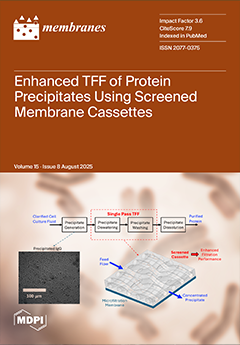The demand for anion exchange membranes (AEMs) is growing due to their applications in water electrolysis, CO
2 reduction conversion and fuel cells, as well as water treatment, driven by the increasing energy demand and the need for a sustainable future. However, current
[...] Read more.
The demand for anion exchange membranes (AEMs) is growing due to their applications in water electrolysis, CO
2 reduction conversion and fuel cells, as well as water treatment, driven by the increasing energy demand and the need for a sustainable future. However, current AEMs still face challenges, such as insufficient permeability and stability in strongly acidic or alkaline media, which limit their durability and the sustainability of membrane fabrication. In this study, polyvinyl alcohol (PVA) and chitosan (CS) biopolymers are selected for membrane preparation. Zinc oxide (ZnO) and porous organic polymer (POP) nanoparticles are also introduced within the PVA-CS polymer blends to make mixed-matrix membranes (MMMs) with increased OH
− transport sites. The membranes are characterized based on typical properties for AEM applications, such as thickness, water uptake, KOH uptake, Cl
− and OH
− permeability and ion exchange capacity (IEC). The OH
− transport of the PVA-CS blend is increased by at least 94.2% compared with commercial membranes. The incorporation of non-porous ZnO and porous POP nanoparticles into the polymer blend does not compromise the OH
− transport properties. On the contrary, ZnO nanoparticles enhance the membrane’s water retention capacity, provide basic surface sites that facilitate hydroxide ion conduction and reinforce the mechanical and thermal stability. In parallel, POPs introduce a highly porous architecture that increases the internal surface area and promotes the formation of continuous hydrated pathways, essential to efficient OH
− mobility. Furthermore, the presence of POPs also contributes to reinforcing the mechanical integrity of the membrane. Thus, PVA-CS bio-based membranes are a promising alternative to conventional ion exchange membranes for various applications.
Full article






